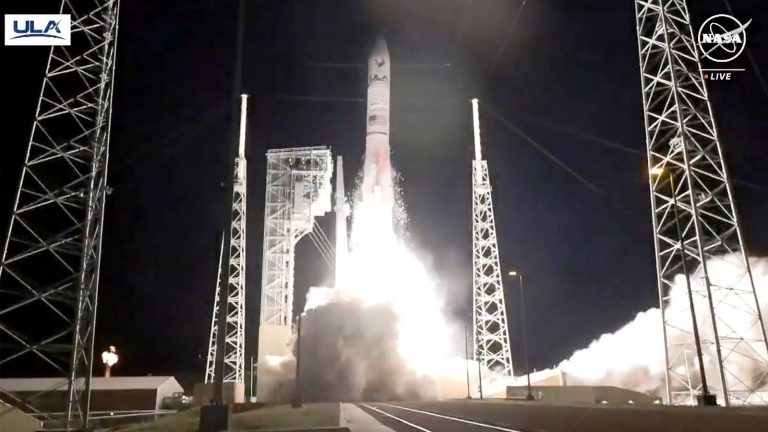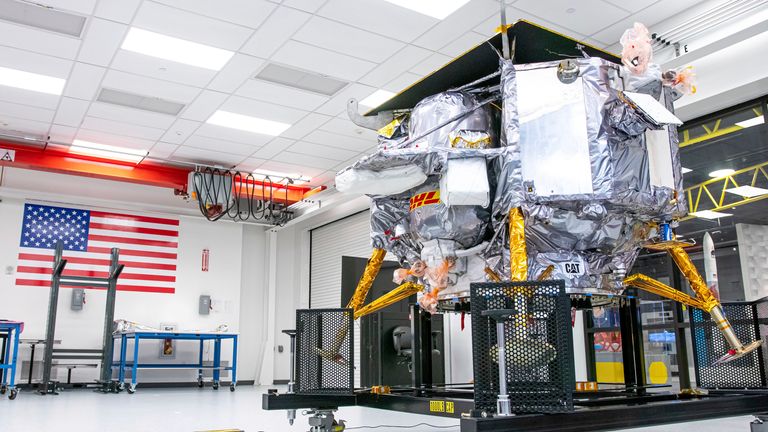Astrobotic has abandoned the landing of its Peregrine-1 spacecraft on the moon after it developed a crippling propellant leak.
The problem occurred in the first few hours of the lunar lander's flight into space.
The Pittsburgh-based company, which had hoped to be the first private company to complete a lunar landing, said there was “no chance” the spacecraft would be able to survive the landing.
“Given the propellant leak, there is unfortunately no chance of a soft landing on the Moon,” Astrobotic said in a statement.
However, the company said the lander has enough fuel to allow it to operate “as a spacecraft” while engineers decide its new mission in orbit.
US Space Agency NASAThe company, which paid $108 million (£85 million) to send scientific instruments with the lander, had hoped the vehicle would survey an area of the moon before the planned landing next year.
However, NASA announced on Tuesday, following Astrobotic's statement, that it had postponed the landing of astronauts on the moon until at least 2026.
What happened to Peregrine?
Peregrine Mission-1 took off from Florida aboard a new Vulcan rocket at 7.18am UK time on Monday and was scheduled to land on February 23.
It was supposed to be the first American spacecraft to land on the moon since the Apollo 17 mission in 1972. It appears to be launching into space as planned.
the Problems with the Peregrine Mission-1 lander It was reported about seven hours after the pre-dawn launch Monday from Cape Canaveral Space Force Station.
Astrobotic previously said Peregrine “successfully” separated from the rocket but an “anomaly” occurred.
The company said Problem with the payment system “The spacecraft's ability to soft-land on the Moon was threatened.”
Astrobotic said an image taken by a camera mounted on the lander showed a “disruption” in a section of the thermal insulation, which is consistent with what was known so far about the problem.
The company aimed to be the first private company to successfully land on the moon, something that only four countries had achieved.
A second lander from the Houston company is scheduled to be launched next month. NASA gave the two companies millions to build and fly lunar landers.
The space agency wanted privately owned landers to survey the area before the astronauts arrived while providing technical and scientific experiments to the space agency, other countries and universities.
Read more
Why is the moon mission important?
Sports drink and human remains – is this lunar mission consistent with science?
The $108m (£85m) paid to Astrobotic, a space logistics startup, was a fraction of the cost of launching one of NASA's special missions.
The lander, about the size of a garden shed, also carries the remains of several Star Trek cast members and the DNA of former US presidents including John F. Kennedy.
NASA postpones its landing on the moon
The last time the United States launched a lunar landing mission was in December 1972. Gene Cernan and Harrison Schmitt of Apollo 17 became the 11th and 12th men to walk on the moon.
NASA was planning to return astronauts to the surface of the moon within the next few years as part of its Artemis program.
However, the space agency on Tuesday postponed its manned flight around the moon – Artemis 2 – to September 2025 due to technical problems.
Reuters had previously reported, citing two unnamed sources, that the mission was scheduled to be postponed beyond its planned target of late 2024 after problems were discovered in the batteries of the Orion crew capsule manufactured by Lockheed Martin during vibration tests.
NASA has also postponed the first human landing on the moon in 50 years – Artemis 3 – to September 2026.



